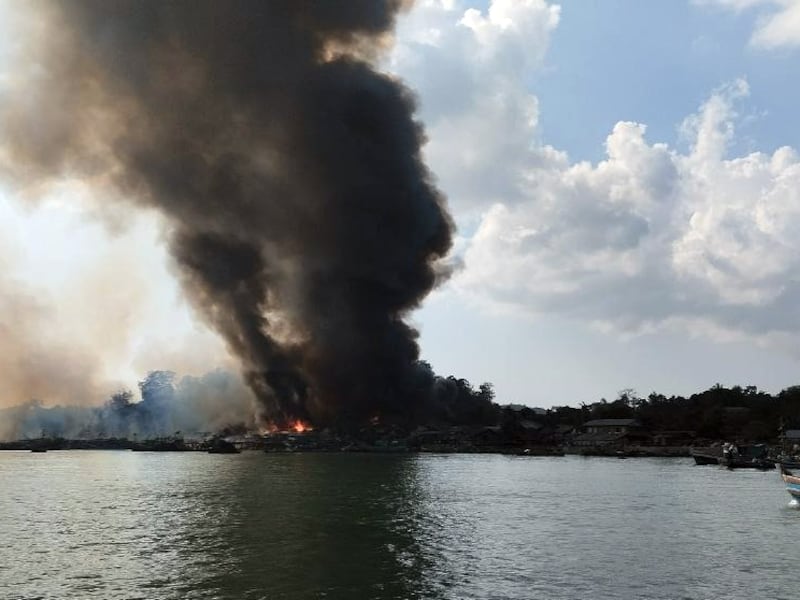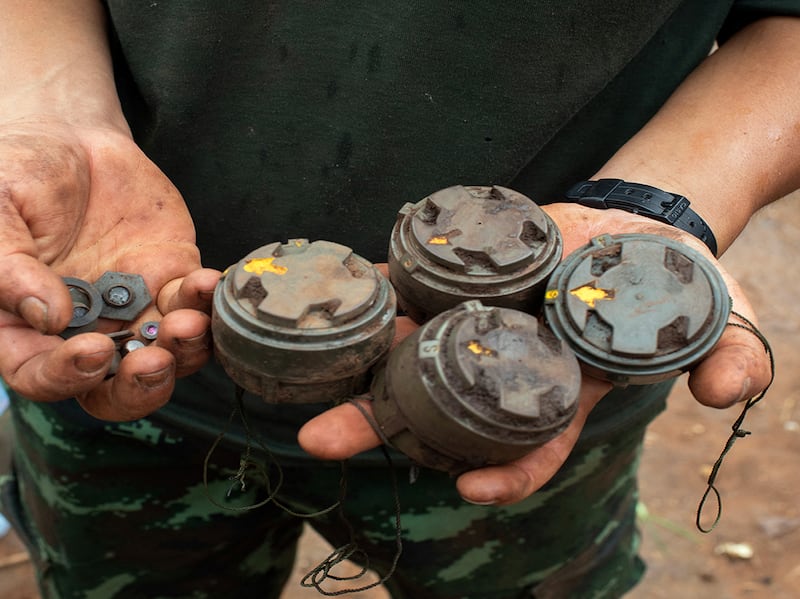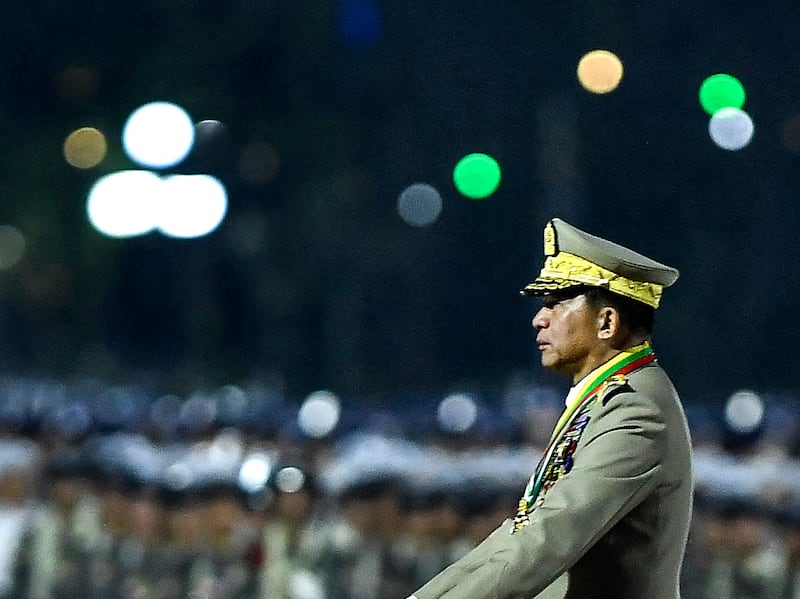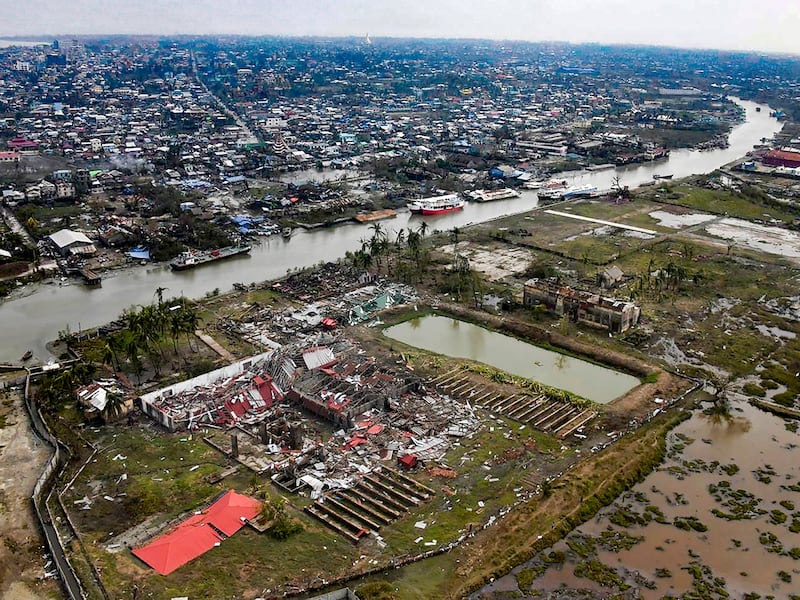Myanmar’s military approaches the fourth anniversary of the coup d’etat that put them in power in terminal decline.
The economy continues to atrophy, with even more pronounced energy shortages, less foreign exchange, and an even larger share of the budget allocated to the military.
The battlefield losses are staggering, as the opposition has withstood Chinese pressure to stop their offensives, and continues to hand the over-stretched military defeat after defeat. Opposition forces now control two of the 14 military regional commands.
According to the National Unity Government (NUG) Ministry of Defense, the opposition is in full control of 95 of 330 townships, while the State Administrative Council (SAC), as the junta calls itself, had full control over 107 townships.
By the junta’s own admission, they are only able to conduct a census and safely organize elections in 161 of Myanmar’s 330 townships.
Losses on all battlefronts
Having taken 15 of 17 townships in Rakhine state, the Arakan Army is now in almost total control of the key western state. They’ve surrounded the Rakhine capital of Sittwe and come up to the border of Kyaukphyu where China’s special economic zone and port are located.
Although the capture of Buthidaung and Ann were neither quick nor easy, the AA was able to sustain sieges of over a month at each, and in the case of the former, tunneled beneath the last military outpost in a stunning display of grit.
Having captured the southern city of Gwa, the Arakan Army has now crossed into Ayeyarwaddy, taking the fight into the Bamar ethnic majority heartland.

In the north, the Kachin Independence Army (KIA) has shrugged off extensive Chinese pressure, and taken the strategic junction town of Mansi, which will make the overland resupply of the besieged city of Bhamo from Mandalay very hard for the junta.
Fighting is ongoing in Bhamo, Kachin’s second largest city. The KIA is now in control of well over half of Kachin, including most of the resource rich regions.
Although they are known for fractiousness, Chin opposition forces are now in almost full control of that state that borders India and Bangladesh, holding five of nine townships, roughly 85% of the territory.
In Shan state, the Myanmar National Democratic Alliance Army (MNDAA) and the Ta’ang National Liberation Army (TNLA) temporarily succumbed to Chinese pressure to stop their offensive in November, but they’ve neither surrendered Lashio nor ceded territory, despite airstrikes.
Citing a new military offensive in Naungcho township, the TNLA, which controls nine townships, announced an end to the ceasefire on Jan. 9.

In eastern Myanmar, Karenni resistance have continued to battle, despite concerted military regime efforts and airstrikes, and their acknowledged ammunition shortages. The Karenni National Defense Force and allied People’s Defense Forces (PDFs) militias claim to control 80% of Kayah state.
Further south, the Karen National Liberation Army and allied people’s defense forces (PDFs) are slowly taking pro-junta border guard posts along the frontier with Thailand.
In Tanintharyi, local PDFs have increased their coordination and are pushing west from the Thai border towards the Andaman Sea coast, diminishing the scope of the military-controlled patchwork of terrain in Myanmar’s southernmost state.
Some of the most intense fighting of late has been in the Bamar heartland, including Sagaing, Magway, and Mandalay.
The military has stepped up their bombings, artillery strikes, and arson, intentionally targeting civilians for their support of the opposition forces. A number of PDFs have expanded their operations into the dry zone.
Mounting troubles
The Myanmar military regime faces severe headwinds as the fourth anniversary of the Feb. 1, 2021 coup approaches.
Prisoners of war from multiple fronts have recounted that the military’s ability to resupply and reinforce troops in the field has all but broken down.
They have a limited number of heavy lift helicopters, including three new Mi-17s that entered service in December. But even those are vulnerable: Some six Mi-17s and two other helicopters have been lost since the coup.
In some cases, the military has tried to parachute in supplies, but those often fall into the hands of the opposition forces.

Nothing demoralizes troops more than the feeling that the headquarters has abandoned them.
The military has always treated Myanmar as a country under occupation, with thousands of remote outposts scattered throughout the country. The NUG claims that opposition forces have captured 741 of these through 2024, and they continue to fall.
The military is increasingly short of manpower. Over a thousand POWs have been taken in recent months, more have surrendered and others have deserted.
The military has now taken in nine tranches of conscripts, amounting to roughly 45,000 troops, and is increasingly dragooning men. But they are deployed almost immediately and are untrained and poorly motivated, in sharp contrast with ethnic resistance organizations (EROs) and PDFs.
That loss of manpower includes senior officers. The NUG claims that in 2024, 53 senior officers, ranked colonel to major general, were killed, captured or injured.
The military is so broke that they recently announced that they would no longer pay death benefits to conscripts. At the same time, the military is often labeling their dead as “MIA”, rather than “KIA”, to avoid paying benefits.

While the junta fumbles, the degree of tactical battlefield coordination between the legacy ethnic armies and the new PDFs is unprecedented.
Every major offensive outside of Rakhine, entails cooperation between them, and even there, the AA was assisted by Chin PDFs who blocked the military’s resupply from Magway.
The increased PDF operations have been made possible by increased assistance from EROs. The AA and Chin PDFs are pushing in from the west and assisting local PDFs in the Bamar heartland.
The AA’s foray into Ayeyarwaddy was done in concert with local PDFs. The United Wa State Army appears to be defying China by arming and equipping the Mandalay PDF and others that are operating in Mandalay, Magway, and Sagaing.
In its favor, the military has finally caught up to the opposition and effectively employed unmanned aerial systems down to the tactical level.
These include drones that can drop munitions, kamikaze drones, and those for intelligence gathering or for more accurate targeting of artillery.
This has proven costly for the opposition and impeded some of their offensives. Nonetheless, their deployment of drones has been too little too late, and will not fundamentally alter the battlefield dynamics.
The military continues to use air power. Indeed, they put their fifth and sixth SU-30 imported from Russia and three more FTC-2000Gs imported from China into service in December.
It’s the economy
But air power is primarily used as a punitive weapon against unarmed civilian targets, not in support of ground forces.
For example, the Jan. 9 bombing in Rakhine’s Yanbye township that killed 52, wounded over 40 and destroyed 500 homes, had no military utility.
Finally, the state of the economy is even more precarious given the loss of almost all border crossings.
RELATED STORIES
Chinese aid cannot overcome Myanmar junta’s declining finances and morale
Perhaps it would be better if Myanmar’s civil war became a ‘forgotten conflict’
Myanmar’s junta answers rebel proposal for talks with week of deadly airstrikes
Although the SAC technically still controls Muse and Myawaddy, which links them to China and Thailand, respectively, opposition forces control much of the surrounding territory.
While Karen forces have not made a bid to take Myawaddy, the main border crossing, they are pinching in along Asia Highway 1 to Yangon.
On Jan. 11, some 500 reinforcements in 30 armored personnel carriers were deployed from Hpa-An to Kawkareik in Kayan state near the Thai border to keep the last main overland trade artery open.
To sum it up, the junta is entering the fifth year of military rule with its power rapidly slipping away.
Although they still control one-third of the country – land that holds two-thirds of the population – their mismanagement of the economy has left the military regime broke.
Spread too thin across too many fronts simultaneously, it’s hard to see the SAC doing anything to arrest their terminal decline in 2025.
Zachary Abuza is a professor at the National War College in Washington and an adjunct at Georgetown University. The views expressed here are his own and do not reflect the position of the U.S. Department of Defense, the National War College, Georgetown University or Radio Free Asia.
